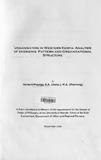| dc.description.abstract | The study seeks to examine the emerging pattern and organizational structure of urbanization in Western Kenya. Kenya, like many developing countries has experienced rapid urbanization over the last thirty years. At the same time Kenya has been a test case for various urbanization strategies beginning with the service center and growth center strategies formulated in the late seventies. Despite this, urban primacy has persisted in the country although the share of urban population in the first two urban centers (Nairobi and Mombasa) has declined. In the Western Region of Kenya the principal urban centers have grown much slowly than previously predicted and generally no town has strong dominance.
The study therefore seeks to analyze the forces shaping urbanization in Western Kenya, and specifically examine to what extent there is an emerging polycentric pattern and organizational structure of urbanization in Western Kenya. Polycentricity refers to a situation where the system lacks dominant nodes because specialized opportunities are distributed across urban areas. Polycentricity is articulated in Polycentric Urban Regions (PUR) which are spatial configurations characterized by the clustering of more or less similar-sized urban centers close together and lacking a clear hierarchy between them thus providing for a unique urban pattern.
Studies in the developed world indicate that Polycentric Urban Regions are at epicenter of a fundamental transformation of advanced economies with superior economic performance. The service center and growth center urbanization policies pursued by Kenya sought to promote a balanced urban system with clear hierarchical structure which was expected to spur development in the hinterland. However, poverty levels in the hinterland of the principal urban centers in Western Kenya Region have increased over time. The study, therefore, aims at contributing towards developing responsive policies for the development of a dynamic and integrated system of urban centers that will positively contribute to regional and national development.
The study is cross-sectional in that the units of analysis were all the urban centers within the urban fields of the three principal towns in the region (Kisumu, Eldoret and Kakamega) with population of 2000 and above. The three towns are the major centers of administration, commerce, industry and education in the western region. A number of approaches were used in examining the pattern of urbanization in the western Kenya. First, the morphological dimension was analyzed using the rank size and primacy indices; and Gini and Area concentration indices.
The functional dimension was analyzed using the Scalogram, weighted centrality indices, frequency distribution and regression analysis. Lastly, governance was investigated in the context of creation of conditions to foster collective action especially among the public actors to deliver on regional planning and development. This was broken down into two main aspects namely: positive-sum partnership or cooperation and institutional interlinkages.
Findings of the study show that the urban system in western Kenya has significant tendency towards polycentricism as manifested in the structure of the central places and to a certain extent the functional specialization and therefore potential for interaction and complementarity. However, the aspect of cooperation or positive-sum partnership is not well developed but several positive indicators point to latent potential for it. This conclusion is further supported by presence of basic prerequisites of PUR including: political, administrative and historical distinctiveness of the three central places and proximity.
The study therefore proposes: recognition of the urban centers as important actors in development and not as mere facilitators of rural and agricultural development; re-orientation of the planning framework to include an intermediate level between the 'regional' and local levels i.e. the PUR; the urban development policy should promote a network of urban places that will engender synergy and regional growth and development. | en_US |

